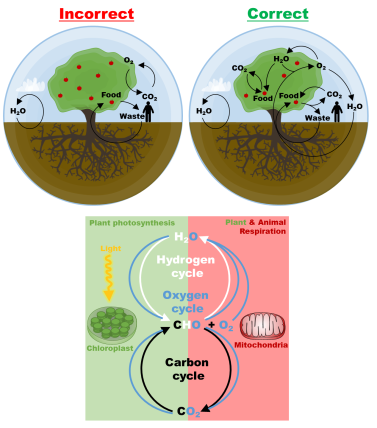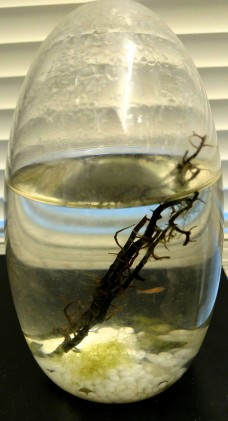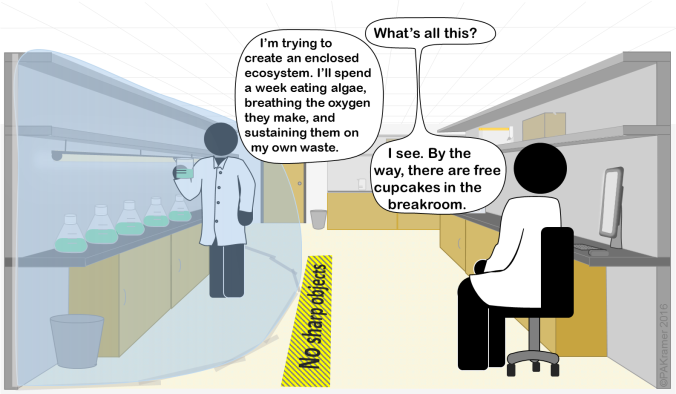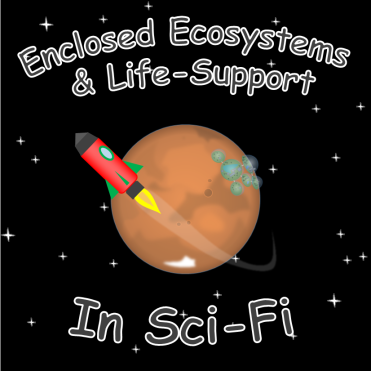Earlier today I did a guest post for fellow blogger, writer, and scientist, Dan Koboldt. I came across his blog about a month ago. He and I share the same mission, to promote the use of accurate science in sci-fi. But rather than do all the background research on his own, he wisely seeks out professionals in related fields and asks them to write about scientific misconceptions in sci-fi and how to get it right. Since my own lab work concerns cellular respiration, I offered to write a post for him on enclosed ecosystems, and he generously agreed. You can see the original post by clicking on the graphic below:
Enclosed ecosystem and life-support systems in sci-fi
A Closed Ecological System (CES) is a broad term that encompass any self-sustaining and closed system in which matter does not leave or enter. These artificial habitats can be built in space, underground, or underwater, but no matter where they are, chances are they are closed for a reason. Whether it is an underground bunker in a post-apocalyptic setting, a distant planet in the early stages of colonization, or a spacecraft carrying the last remnants of humanity, the environment outside is not hospitable. To ensure long-term survival, the occupants must maintain a well-balanced air and water system, a continuous food supply, and a reliable source of energy.
So far, no artificial enclosed ecosystem has successfully supported human life for long periods of time. Even the astronauts on the International Space Station get regular supply runs and have to exchange personnel. The largest CES was Biosphere 2, which sustained 8 crew for 2 years; however, they had to resort to some extreme measures to keep oxygen and carbon dioxide levels in normal ranges, and many of the plant, animal, and insect populations died off.
Creating and maintaining a CES is difficult, as many fluctuations or imbalances can cascade into environmental collapse without continuous monitoring and support. Here I will discuss a few of the misconceptions about Enclosed Ecosystems and Life Support systems and suggest ways to get it right in Sci-fi.
Myth: Waste is useless and should be disposed of.
You see this in many sci-fi stories set in space; the airlock door opens and a stream of garbage is ejected into the vacuum. This might be acceptable for short-term missions, where all the supplies needed are carried along, but for an ecosystem intended to last for a long time, being wasteful is not an option. It is a matter of mass balance. In most situations, it won’t be possible to obtain resources from outside the enclosed system, so if your characters are ejecting waste of any kind out the airlock, soon there won’t be anything left. By the same principle, if some waste product cannot be recycled, it will build up and eventually consume all of the precursor materials.
Getting it right
When creating a life-support system for a fictional crew, they must adhere to a strict recycling policy. Most solids, such as plastics and metals or glass, can be melted and recast into any number of shapes. Of greater importance is the conversion of gaseous, liquid, and solid wastes into breathable air, drinkable water, and edible food. Solid organic wastes such as material from dead plants, animals, or their excrement, contain large amounts of nitrites and nitrates, phosphates, and other inorganic compounds that serve as fertilizer for plants.
Having a ‘living soil’ or cultured hydroponic system is also necessary, as bacteria, like those found in the human gut, are great at breaking down complex organic molecules and making them assessable to the roots of plants. So far, there is no easy way to convert waste, carbon dioxide, and water into an edible food source, outside of a biological system, such as a plant. Such plants can be consumed as food, and the cycle is repeated.
Myth: Water evaporates and condenses, but the total amount doesn’t change.
You hear this often in terms of a large environment like the Earth, where water rises from the oceans and falls again as rain, and it is true for the most part. Only a few processes create or break down water, but in a small, highly balanced environment, they can make a huge difference. Water is made and destroyed in biological systems during condensation reactions and hydrolysis reactions, respectively.
But the most significant of these reactions occurs in the mitochondria, the ‘energy’ producing organelle in nearly every cell. In the mitochondria, oxygen receives 4 electrons from the Electron Transport Chain and is reduced to water. Yes, nearly all of the oxygen you absorb through your lungs is converted into water. The reverse happens in plants, where water is hydrolyzed into oxygen during the construction of carbohydrates during photosynthesis.
Getting it right
The balance between animal and plant life on the ship should ensure a stable supply of water, but water can be made and eliminated artificially if there is ever an imbalance. Electrolysis, breaking water into hydrogen and oxygen, can be accomplished with a little electricity. That processed can be reversed by burning hydrogen in the presence of oxygen. A means of storing oxygen and hydrogen or water should be in place to deal with small fluctuations. Humidity and condensation can cause severe damage to electrical systems, especially in zero gravity, where air currents can become stagnant. This also increases the risk of mold. Cold surfaces or specialized air filters can trap the water vapor and return it to storage.
Myth: Plants convert carbon dioxide into oxygen, while animals do the opposite.
Unfortunately, the biochemistry isn’t so simple. Oxygen is not converted into carbon dioxide in animals. As I already mentioned, nearly all of the oxygen you absorb is converted into water. Carbon dioxide is released from the breaking down of metabolites like sugar, proteins, and fats. This takes place in the mitochondria. In plants, oxygen is made when both carbon dioxide and water are converted into carbohydrates like glucose during photosynthesis. This occurs in the chloroplast in plants.

Another misconception is that producing oxygen is all plants do. In reality, plants have mitochondria too, and they consume oxygen and carbohydrates and produce carbon dioxide and water. When the lights are on, plants tend to produce more oxygen than they consume, but without light, they will suck up the oxygen as hungrily as we do.
Getting it right
Even as little as 1% concentrations of carbon dioxide can cause acute health effects such as fatigue and dizziness, but even higher concentrations (7-10%) can lead to unconsciousness, suffocation, and death within hours. To control fluctuations in carbon dioxide, CO2 scrubbers can be used. However, carbon dioxide is an intermediate step in oxygen and carbon cycles, so this artificial means to lower carbon dioxide may cause downstream effects on plant growth and lower oxygen concentration. This occurred accidentally in Biosphere 2 when carbon dioxide was converted into calcium carbonate in exposed concrete.
Materials like metal oxides and activated carbon can be used in CO2 scrubbers and then the carbon dioxide can be released at a later time. Large variations from the normal 21% oxygen is more easily tolerated than variations in carbon dioxide, but long-term exposure to greater or lower concentrations can lead to many acute and chronic health effects. Adjusting the amount of artificial or natural light available for photosynthesis is an effective means of controlling oxygen concentrations.
Myth: Energy must be produced within the ecosystem.
No closed ecological system is completely enclosed. If it were, it would soon succumb to the laws of entropy, making it a very cold and dark place. Something has to enter the system, and that thing is energy. The energy driving the weather, the currents, and the very life on this planet is coming from the sun.
Getting it right
Most common energy sources:
- Solar
- Wind
- Water
- Geothermal
- Gas
- Fusion/fission
The first four examples are the only types applicable in a completely closed ecological system, since energy can be moved into the system without any exchange of matter. A major drawback, however, is that the habitat can’t leave the source of the energy. A spaceship powered by the sun will have a hard time operating in interstellar space.
Any technology that requires the use of combustible fuels or fissionable (uranium 235 or plutonium 239) or fusible (Hydrogen 2 and 3, deuterium and tritium, and helium) materials will have to be resupplied on a regular basis, so they are not suited for long term ecosystems. By nature of their bi-products, they cannot be reused for more energy, but they have the benefit of being disposable and can be used as a form of thrust in spaceships without upsetting the mass balance.
Other Considerations for Environmental Control and Life Support.

My year old Ecosphere. Going strong except for a slight algae overgrowth (The lab decided to keep lights on around the clock this past month).
Size- Closed ecological systems can come in all shapes and sizes, but the larger the better. Larger ecosystems, like the Earth, can sustain much more life and complexity and take longer to collapse if poorly maintained.
Nutrition- The nutritional demands of a human are more than getting the right amount of calories. There are many essential trace elements, minerals, amino acids (9 of them), and fatty acids (omega 3 and omega 6) and nearly everything that is classified as a vitamin, that cannot be synthesized by the human body. Until these things can be synthesized by machines, a complex ecosystem of many different plant and animal life forms would be required to maintain optimum human health.
Temperature regulation- Heat will build up rapidly in most enclosed systems, even in the cold of space, especially when you have heat generating electronics around. Heat needs to be dumped back into space as thermal radiation, usually a high surface area radiator that circulates a fluid capable of picking up heat in the interior and then dispensing with it outside. The opposite may be true in the deep ocean or underground, where heat may be drawn out of the enclosed system, and insulation will be necessary.
Air circulation- This is particularly important in zero G space, where hot and cold air will no longer rise and fall, respectively. To prevent air stagnation, humidity fluctuation and condensation, air needs to be well circulated. Filters are also necessary to remove any particulate matter such as skin cells or microbes.
The human element- Most enclosed ecosystems designed to support human life have not lasted nearly as long as they were intended to. Why? Because they failed to factor the human element into the equation. People get lonely and fall in love, personalities clash and people fight. Close quarters and a limited food supply can cause even the most patient and respectful of people to lose their temper. In Biosphere 2, the eight crew were barely on speaking terms by the time they exited, and two of them got married soon after.


Very interesting stuff! And apropos, as I’m just gearing up to write a story set on a long-term enclosed spacecraft. 🙂
LikeLiked by 1 person
Pingback: Writing Update-December | P. A. Kramer
Pingback: The Science of Space Warfare | P. A. Kramer
Pingback: Exploring Alien Worlds on Netflix (Ep4) | P. A. Kramer
This is great! Thank you for putting this information together. What a great ending- no one on speaking terms, two got married. lol
LikeLike